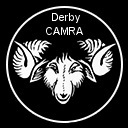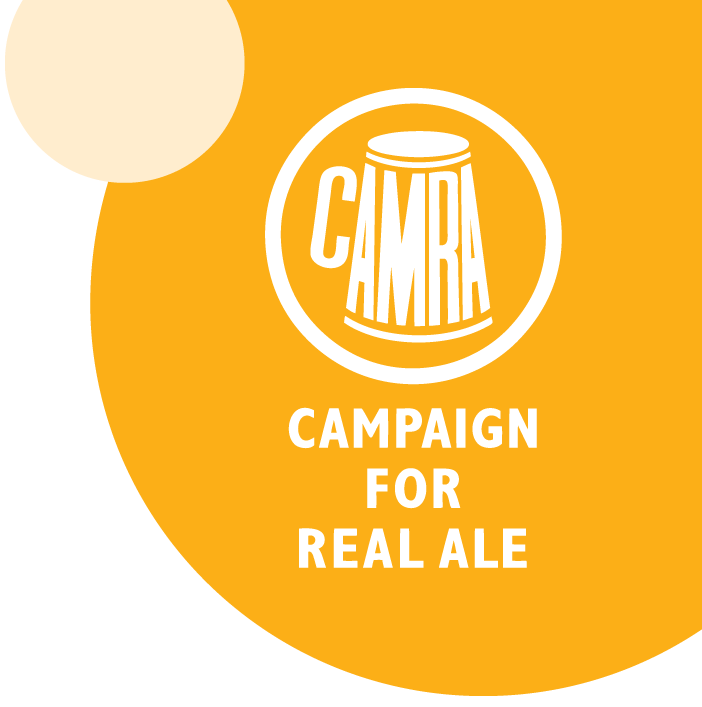History of Derby Pubs
Derby Pub History Trails
Pub Trail 1 - Derby Center East: Brunswick to the Tap via the Alexandra Hotel, Smithfield, Exeter and Peacock.
Click on this link to download the trail in PDF format.
Pub Trail 2 - Derby Cathedral Quarter: Silk Mill to the Old Bell via the Dolphin, Standing Order and Jorrocks.
Click on this link to download the trail in PDF format.
Existing Pubs of Historic Interest
Tap on the pub name to expand the section and reveal the text for that pub.
Designed in 1871 by GH Sheffield it once stood close to a short arm of the Derby Canal. It is named after the wife of the future King Edward VII, son on Queen Victoria. The ground plan of this pub has changed rather more than is immediately obvious. It was built in the 19th Century in a Gothic style with early English pointed arches to the windows. It is now a pub of two halves, with a public bar on the left with a long modern bar counter and the outlines of the snug still evident, a lounge on the right with a much shorter counter. There is a central servery whose off-license hatch survives in the front vestibule. The surprising change is that the lounge used to be upstairs at the front. It was accessed by stairs which ran in the opposite direction to the present ones.
In recent years, the pub has been run by several keen railway enthusiasts and there is a considerable display of railwayana in the public bar which is quite possibly the best pub-based collection of anything this side of Cauldon Low. This includes part of a class 37 locomotive in the car park. Despite when the pub became the birthplace of Derby CAMRA in 1974 it belonged to Shipstone's of Nottingham there is a large, illuminated Home Ales sign in the lounge, produced for Nottingham's other large brewery. Both are now closed. Since then, it has passed from the ownership of Bateman&s of Wainfleet to Castle Rock Brewery, now the largest brewery in Nottingham.
There is no evidence of the former brewhouse on the 1937 map but presumable was inside what was by the then a garage, now the site of the smokers' area, outside at the back of the pub building.
The inn was opened in 1842, intended for the use of railwaymen and second–class passengers. It was originally called "The Brunswick Railway and Commercial Inn". It was the first purpose-built railway inn and served the very first purpose-built railway workers estate anywhere and remained in the ownership of the railways for 105 years.
After a long period of inactivity, the Brunswick re-opened as Derby's first multiple-choice real ale house in 1987, following restoration work undertaken on behalf of the Derby Civic Society and the Derbyshire Historic Trust.
Standing at the apex of the Railway Cottages Triangle. The purpose–built brewery on site is on view. Stone-flagged bar and adjoining lounge, to one side, family parlour in the apex and long function room above stairs. The extra deep two-level cellar results from the site having been raised significantly to accommodate the level of the newly arrived railway (and probably to allow for the fact that the whole area was once a swamp). Like many of the nearby buildings (including the original railway station) it was designed by Francis Thompson and opened along with the Midland, now Hallmark Hotel, in July 1842.
Ref: Derby Drinker 091
A purpose-built pub erected around 1816, in Regency style, at about the same time as the rest of the area. The pub took its name from the Earl of Essex whose home, Exeter House, stood nearby. The house was demolished, in 1854.
The charm of a rural pub in the urban sprawl of Derby city centre. Small bar with open fire separated from partitioned lounge by chimneybreast, with wooden-settled snug and old-fashioned range to one side. The lounge has been further extended for extra dining. The adjoining atmospheric cottage, dating from about 1815, has been incorporated into the pub.
Sign: Due to an unfortunate error the sign illustrates the arms of the City of Exeter.
Ref: Derby Drinker 103
Built in 1866 as a small hotel and converted to a pub in 1933. The public bar retains its original countertop and a fine bar back, other original Victorian features are present around the building.
The original Flowerpot pub occupied the right hand side building on the corner of King Street and Chapel Street. The entrance on King Street has not changed but the bar has moved from facing King Street on the right as you enter, to the left and facing Chapel Street. The former Central Tyres building next door was taken over and became the stillage bar and gig room.
A survivor of another area which was once well pubbed, a stopping point on the legendary Derby Mile for pub crawlers. Earlier use came from the very wide Friar Gate being in use as a cattle market, pubs being an essential addition to any market. Its most recent refurbishment in a contemporary basic style saw many unsightly, earlier 20th century fittings removed, like the treatment Derby Brewing Company gave to its brewery tap, formerly the Royal Standard.
At the time of the interwar licensing plan the tap room and servery were either side of the front door, with what appear to have been high backed bench seating surrounding the fireplace. The bench seating in the smoke room behind it also surrounded its fireplace. Access to the lavatories was by the yard and there was also access to a club room which was over the rear range of service and living rooms. It appears that was an off sales hatch attached to the exterior of the pub.
One of two pubs in the City Center which are only a fragment of what they once were. The other is The Tiger in Lock-up Yard.
The Jorrocks name is recent and has no historical connection with Derby, but comes from the stories of a fictional sporting gentleman narrated by RS Surtees. The original hotel was the Globe, one of several important coaching inns and hotels facing or near to the original route of London Road which becomes Matlock Road on the northern side. The original frontage included the adjacent building, there were also several complex changes behind which involved the purchase of two former pubs (The Black Boy and The Sun).
By 1935 plan the pub had just two public rooms, a public bar at the front with a long bar counter, and a smoke room at the rear with no bar service. A yard gave access the WCs and an exit onto Sadler Gate. The cellar stairs rose to a floor level hatch cover behind the bar, a feature that was once more common than today. The main surviving historic feature is now the leaded light front window which survived one attempt by its owners to have it removed.
Largely 18th Century multi room pub with drinking passageway. The snug is especially fine with a part glazed, curved partition, like the Holly Bush at Makeney. "Tudorisation" is in evidence, and the kitchen occupies the brew house which was used until 1918.
An inter war (Brewers Tudor) pub, including fine original features such as the panelled counter and arched fireplace in the front bar. Gents& toilets have original urinals and terrazzo floors.
The Old Bell Hotel is Derby's largest and last surviving coaching inn, a beacon of Derby&s history and heritage stretching back over 350 years, revived and restored by owner Paul Hurst. It was considered one of the most prestigious coaching inns outside of London. The Old Tudor Room (once a men-only preserve) has been restored to near its former glory. The front bar (the old "two steps down") has been restored to pristine condition. The former lounge, snug and snooker rooms have reverted to an ornate function room, almost as it was pre-war.
A black and white 17th century, three-storey, timbered building that stands with the entrance at right angles to Sadler Gate. It was the Meynell family who had this fine coaching inn built around 1680. John Campion acquired the freehold in 1780, and added a fine ballroom, which was subject to later alteration. During the floods of 1842, the nine year old grandson of John Campion II was (launched in a wash-tub in the cellars) – the purpose to save some vintage bottles of wine placed there by his great-grandfather!
Curiosities: The builders Ford and Weston added the mock-Tudor timbering as part of a decorative refurbishment in 1929, using timber that had been rescued from other local sites. The Old Bell was not just a coaching inn, it provided many essential services to the people of Derby, including a doctor&s surgery, courtroom and its cellars were even used as prison cells. Remnants of its past are dotted across the building with pathways and tunnels deep in the cellars that lead to various parts of the city.
For more information see the website Bell Hotel History.
This pub has had its history more carefully researched and documented than most. There was an archaeological survey in 2001 which uncovered remains of the original baths after which the pub is named. It was originally built in 1733 by William Chauncey as a rival to the spa of Buxton, but that role did not survive his own death in 1736. It spent almost a century as a private residence or possibly a farmhouse. The premises are listed Grade II; the listing description states the present outline to be from the early 19th Century. It became an inn in 1832, the year of the Beer Houses act which permitted any premises to be licensed on payment of £2 per year, but only for the sale of beer.
A major refurbishment in the 1980s was praised at the time for being less insensitive than most contemporary pub refurbishments. This has left a single open public area, though its original room divisions on two levels are clearly discernible. The function room at the rear of the pub spent some time as a boxing ring. A passageway opposite the end of the bar leads to the men&s lavatories and a side door. It is elegantly tiled in the Victorian or Edwardian Minton style.
The Smithfield is situated on the banks of the River Derwent. Opened in 1840 as the Cattle Market Hotel, it served the patrons of the Cattle Market which stood opposite until 1970. The pub was renamed the Smithfield in 1982. The pub was closed in 2011 and sold at auction in January 2012. It was refurbished and reopened in 2012. The market was later moved further west. The curving front to the building once formed a road corner for traffic passing over the Derwent bridge which was at the side of the pub. The hotel block stood to the side of the present pub in what is now the car park. The entrance to the back of the hotel block can still be seen in the present building to the side of the current enterance. The main building originally had a second front enterance closer to the river and can be seen by studying the different windows.
Ref: Derby Drinker 056
Derby Drinker 094
Derby Telegraph – Cattle Market bridge
Derby Telegraph – Catlle Market bridge demolition
Situated in the Lock-up Yard, once the scene of the brutal murder of a policeman. It dates from 1737, de-signed by Joseph Pickford, when it operated as a coaching inn, and was originally much larger. It was used by travellers between London and Manchester, when the frontage stretched as far as the Cornmarket. The building was restored in 1990.
Located at western entrance to the covered market hall, facing the fish market. Narrow frontage opens onto spacious, many-angled interior providing plenty of snug, tucked away corners. Congenial tavern at-mosphere. Lock-Up Yard is named after the 19th century nick that once held four prisoners charged with plotting to kill Lloyd George (1917). A more recent claim is that it provides access for a subterranean trip down into the barrel-vaulted tunnels beneath the Guild Hall, in search of ghosts.
Celebrated; as Derby&s oldest pub, occupying a 16th century building. Not all as old as it looks, due to (Brewers Tudorisation) and restoration between the wars. A corridor passes through the building, connect-ing 4 rooms, all serviced by a central bar. The front bar quarry tiled, the Offilers Lounge is raised with the remains of bell pushes, there is a further lounge and tiny snug.
Former Pubs Still Standing
The following pubs are permanently closed but the building is still standing and often unaltered.
Former Pubs Still Standing
Derby
Derby City
Borrowash
Findern
Shardlow
Books & Publications
Related Links
Derby
Derby City
-
Arboretum Hotel, 192 Osmaston Road, Derby.
Large corner building on the corner of Osmaston Road and Arboretum Street and opposite the walkin-centre,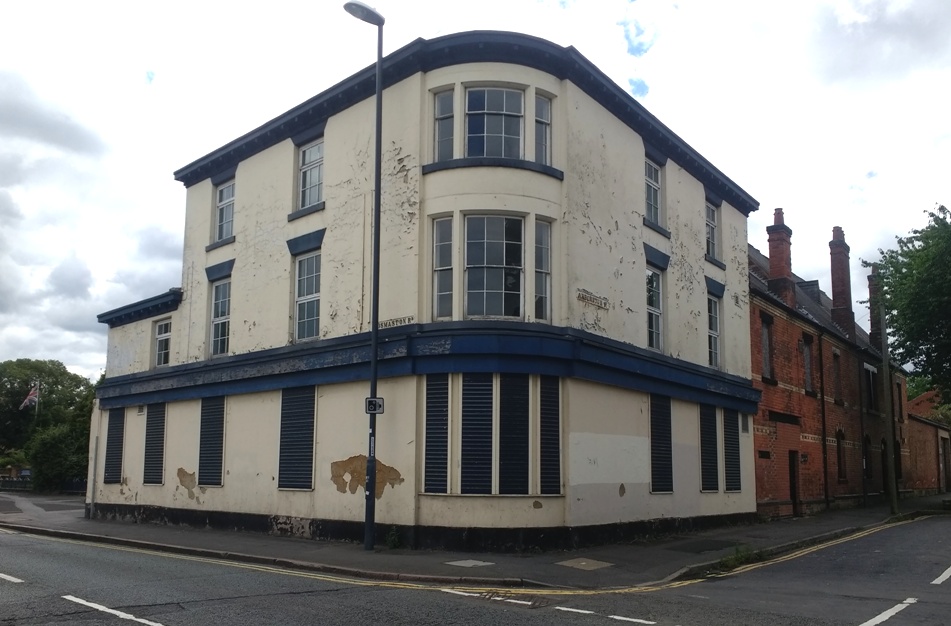 Ref: Derby Telegraph
Ref: Derby Telegraph
-
Barley Mow, Russell Street, Derby.
Two story building on the corner of Osmaston Road and Russell Street.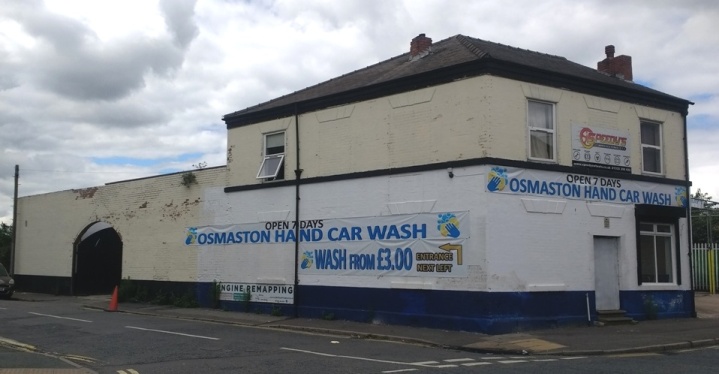
-
Beer Barrel, (formally Football Tavern), 273 Osmaston Road, Derby, DE23 8LD.
Three story building on the corner of Osmaston Road and Horton Street next to the Osmaston Works. Has lain derilict since closing. The Hilton Arms once stood diagnonally across the road.
Ref: Lost Pubs Project -
Crompton Tavern formally Queens Hotel, 46 Crompton Street.
Mid-terrace building approximately half-way along Crompton Street.
Ref: WhatPub - Crompton Tavern -
Crown and Cushion, 1 Midland Road, Derby.
Large corner pub overlooking the junction of London Road and Midland Road opposite the former Florence Nightingale. For the last year or two as a pub it was known by the name Tiffany Lounge. The pub originally consisted of two rooms the larger one on the Midland Road side. The bar sat between the two rooms. Now a convenience store.
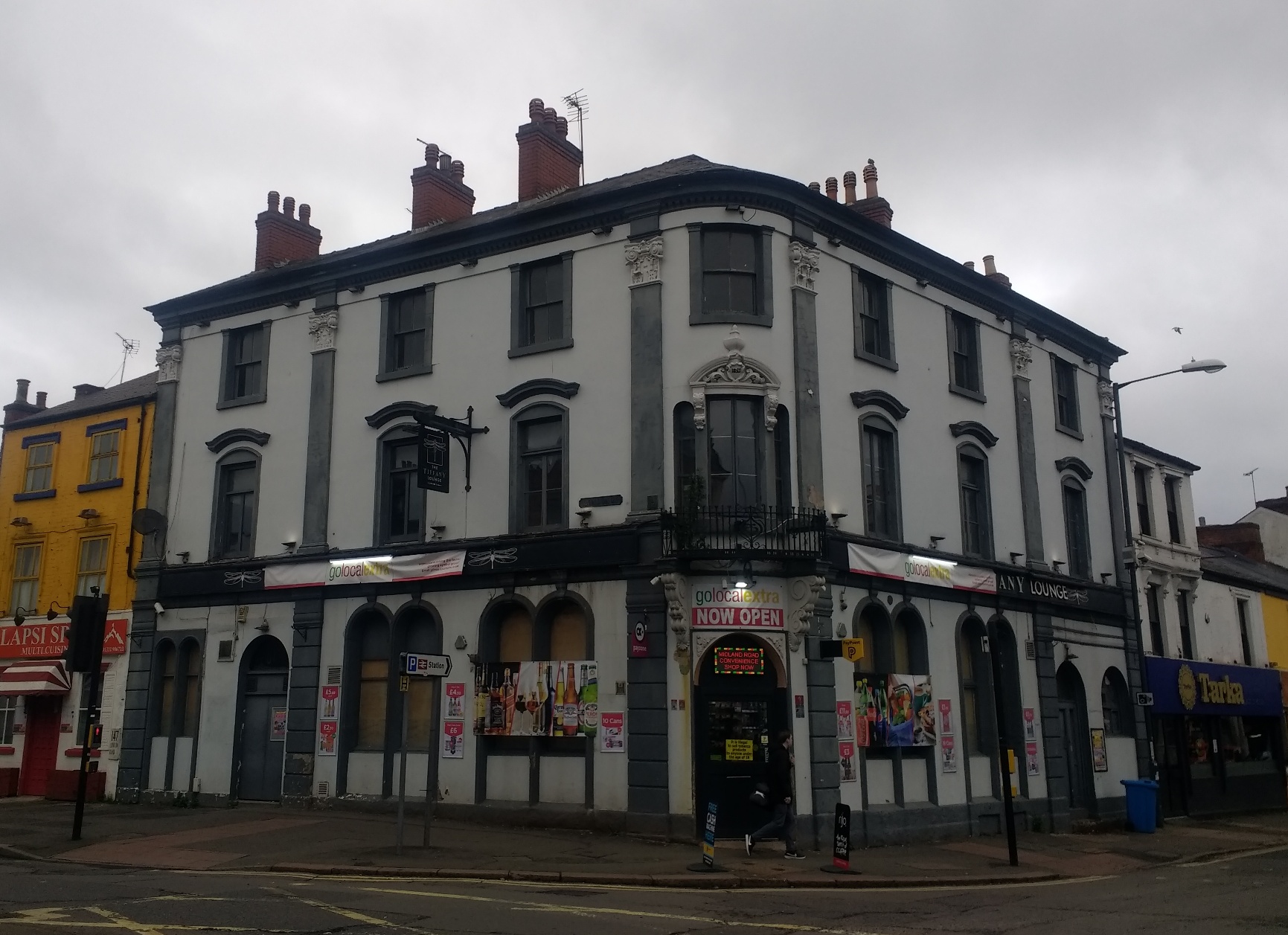
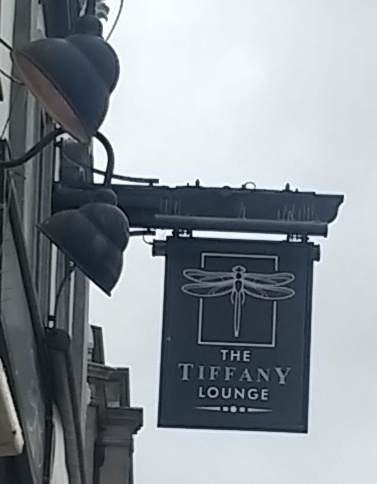
Ref: WhatPub - Crown and Cushion
Ref: Derby Telegraph
Ref: Derby Telegraph -
Duke of Clarence, 87 Mansfield Road, Derby.
Traditional pub on Mansfield Road. Closed in March 2020. Building sold for redevelopment into residential use in December 2020 for £285,000, but still appears untouched in October 2022. Recent rumous suggest it may reopen as a pub.
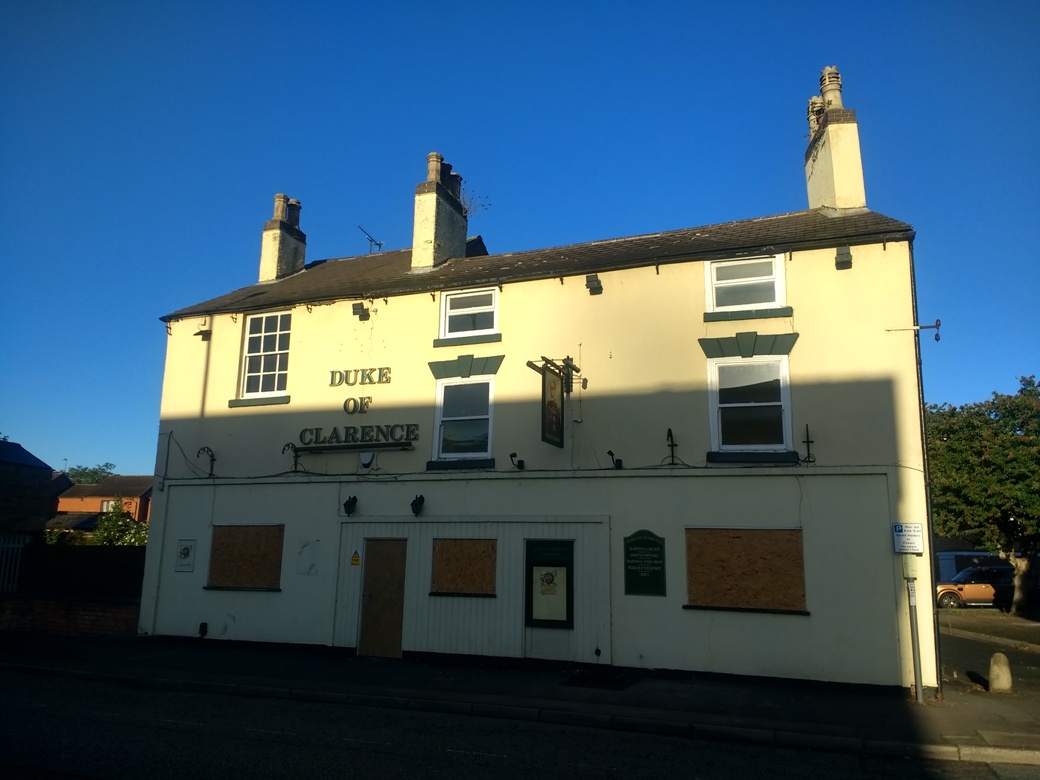
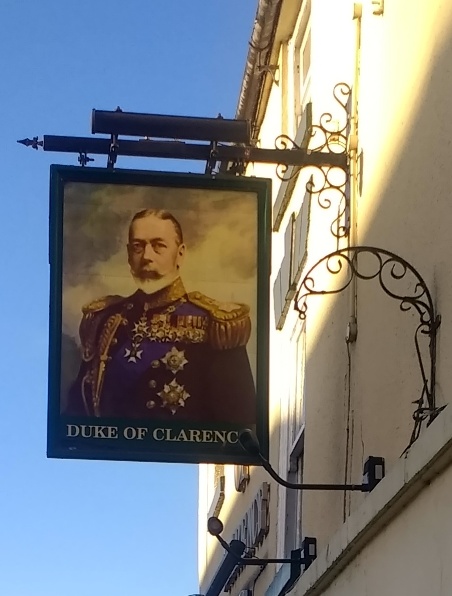
Ref: WhatPub - Duke of Clarence
Ref: Estate Agent
Ref: Derby Telegraph -
Florence Nightingale formally Nottingham Arms, 111 London Road.
Corner of London Road and Litchurch Street.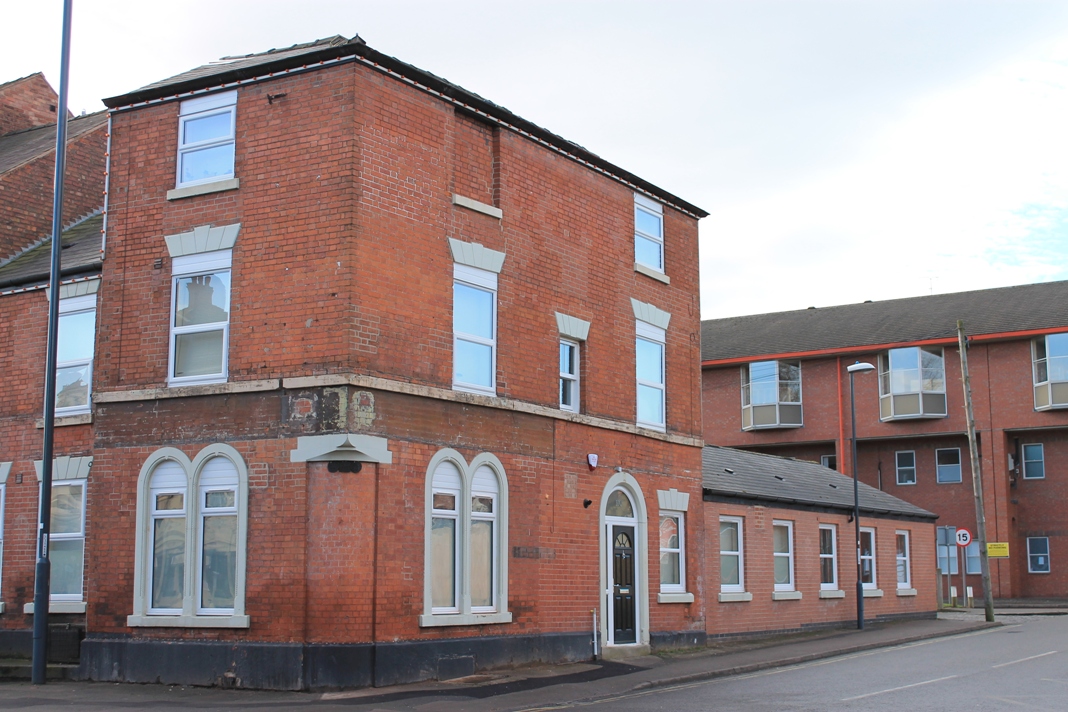
-
Galliant Hussar, 110 Ashbourne Road, Derby.
Corner of Ashbourne Road and Noel Street. Now residential.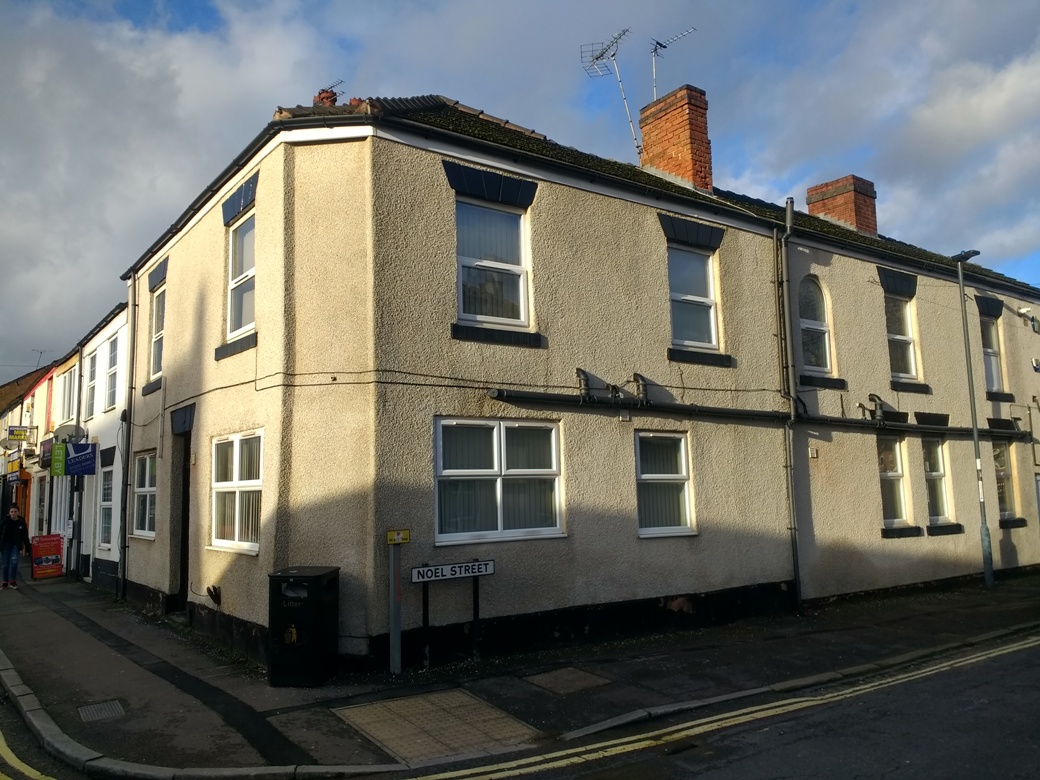
-
Garden City Tavern, Vivian Street, Chester Green, Derby, DE1 3RZ.
Situated on the corner of Vivian Street close to the railway line. The building still has the pub sign on the corner wall. Now residential.
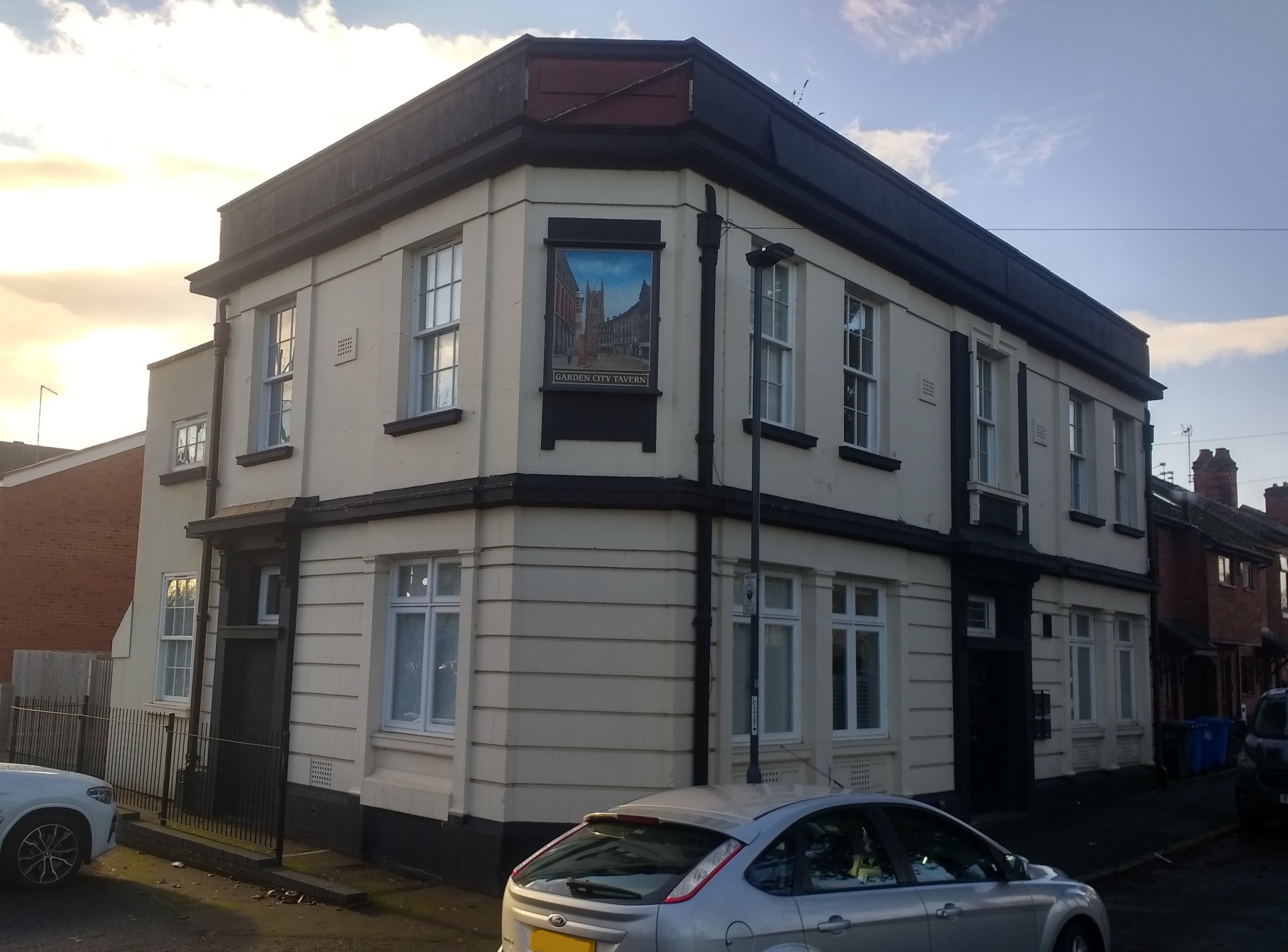
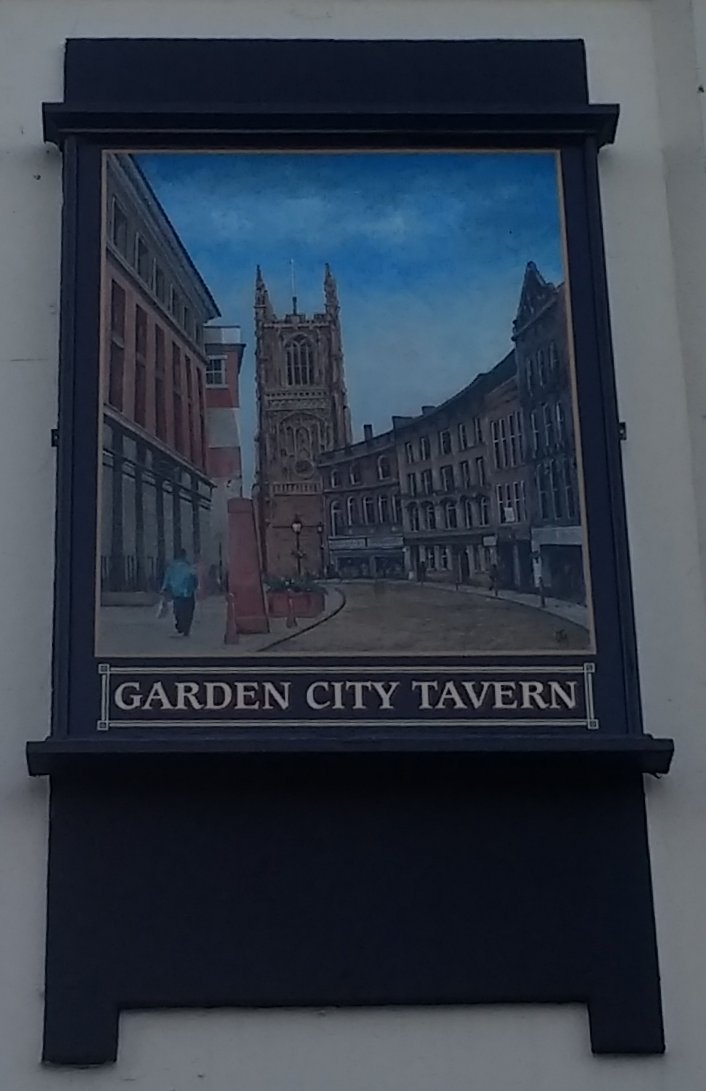
Ref: WhatPub
Ref: Derby Telegraph -
George Hotel, Midland Road, Derby.
Large former Hardy and Hansons pub close to the railway station. Now an Indian restaurant. On entering the pub you were presented with a bar to the right and saloon to the left. The basic layout still exists inside albiet with the walls removed.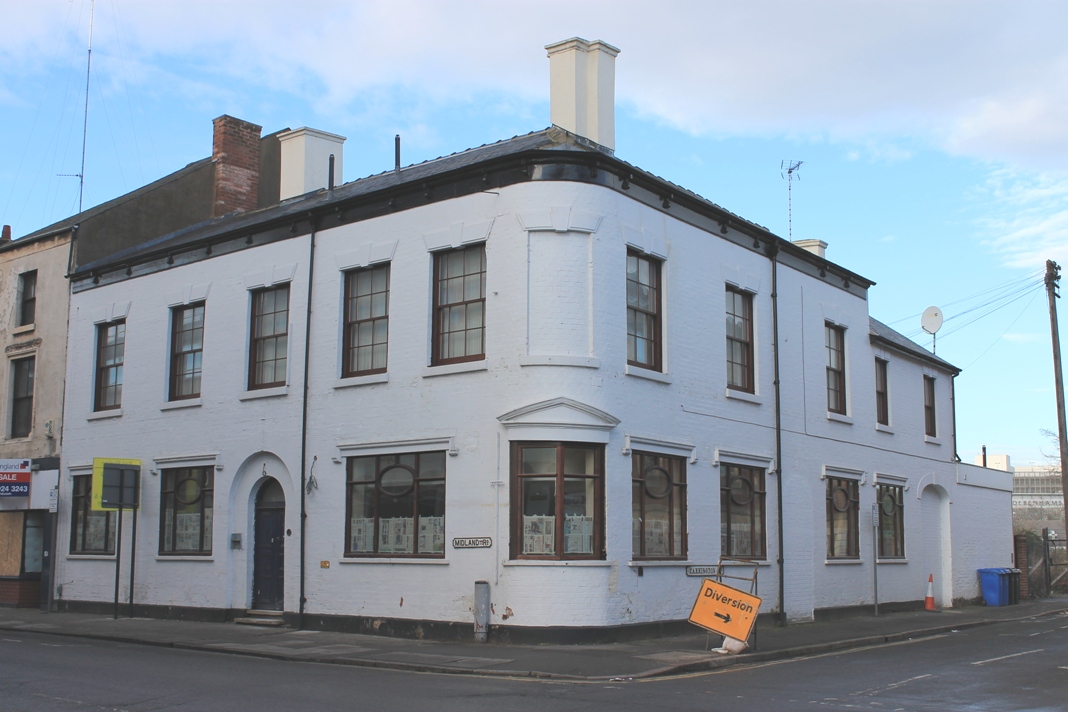
-
Junction Tavern, 12 Junction Street, Derby.
Situated around half-way down Junction Street the building is now flats. Closed around 2020.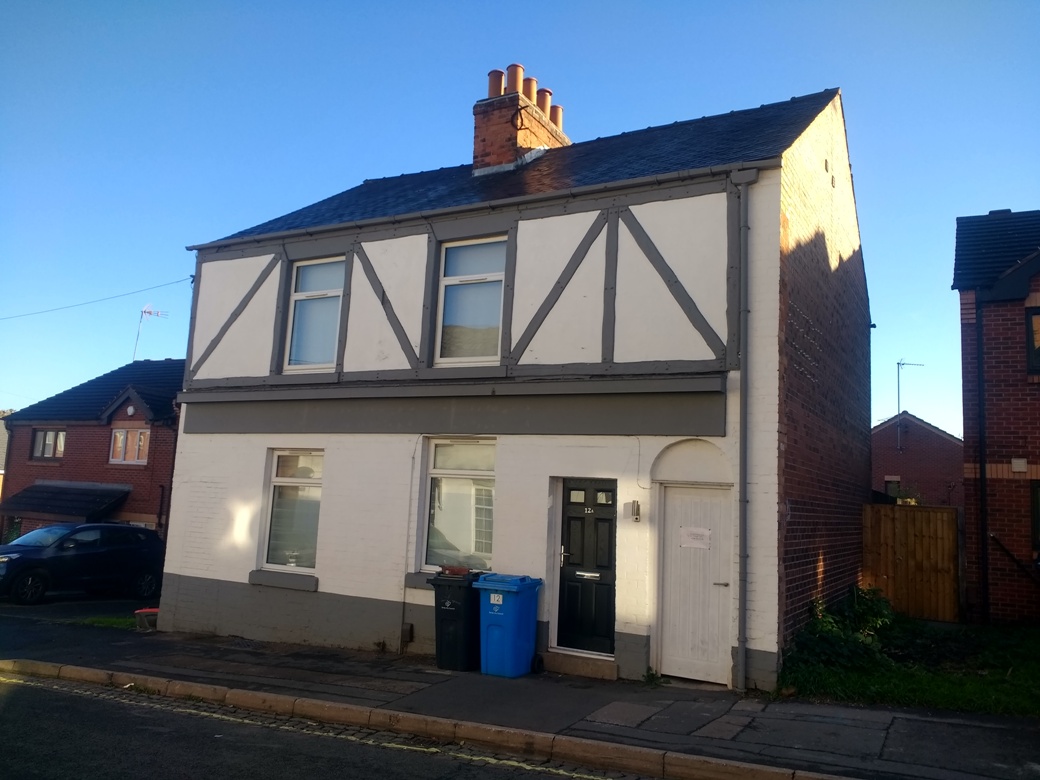
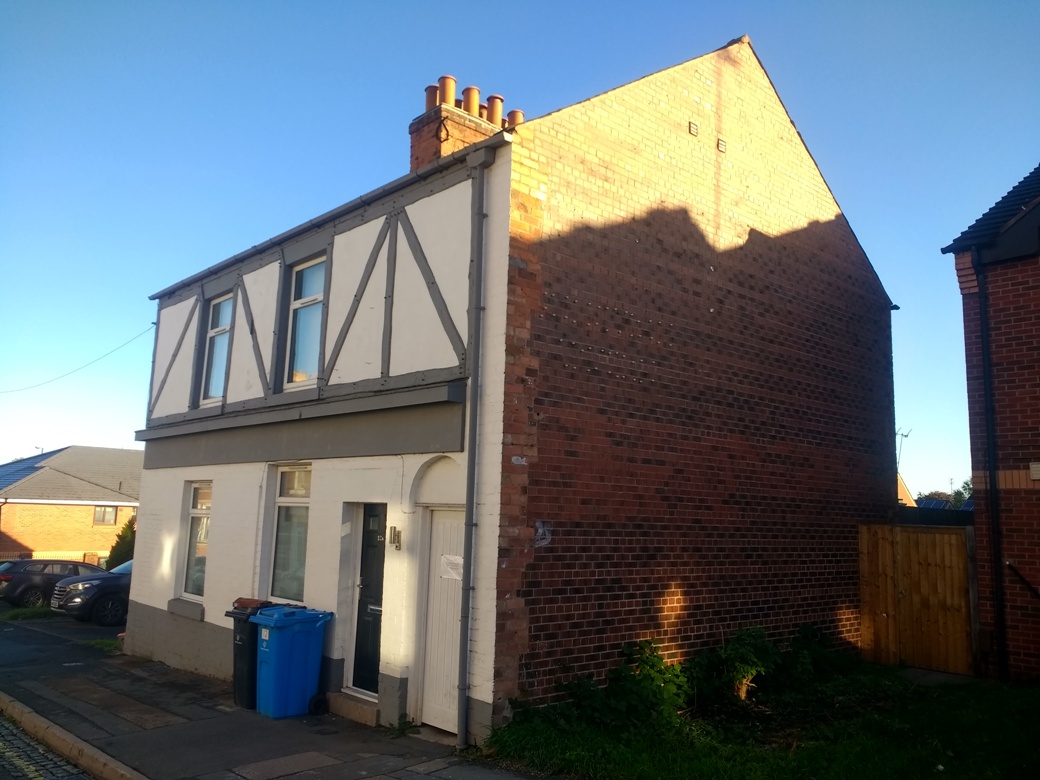
Ref: WhatPub - Junction Tavern -
Litchurch Inn, Derby.
Corner building on the junction of Russell Street and Cotton Lane, now in use as flats.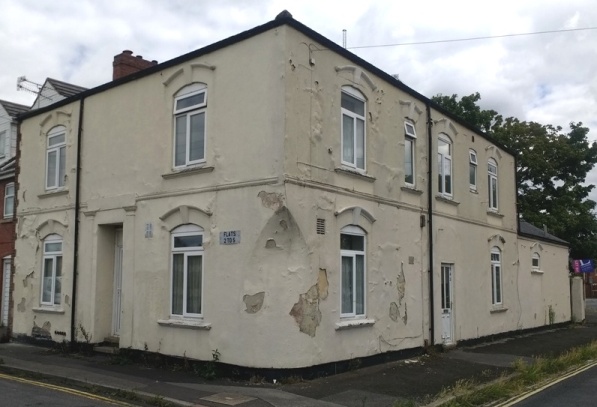
-
Liversage Arms, Old Nottingham Road Derby.
Building on the corner of Old Nottingham Road and Alice Street. Partially hidden by the inner ring-road. Now flats. The entrance on the ring-road side still has the pub name in the ornamental brick-work above.
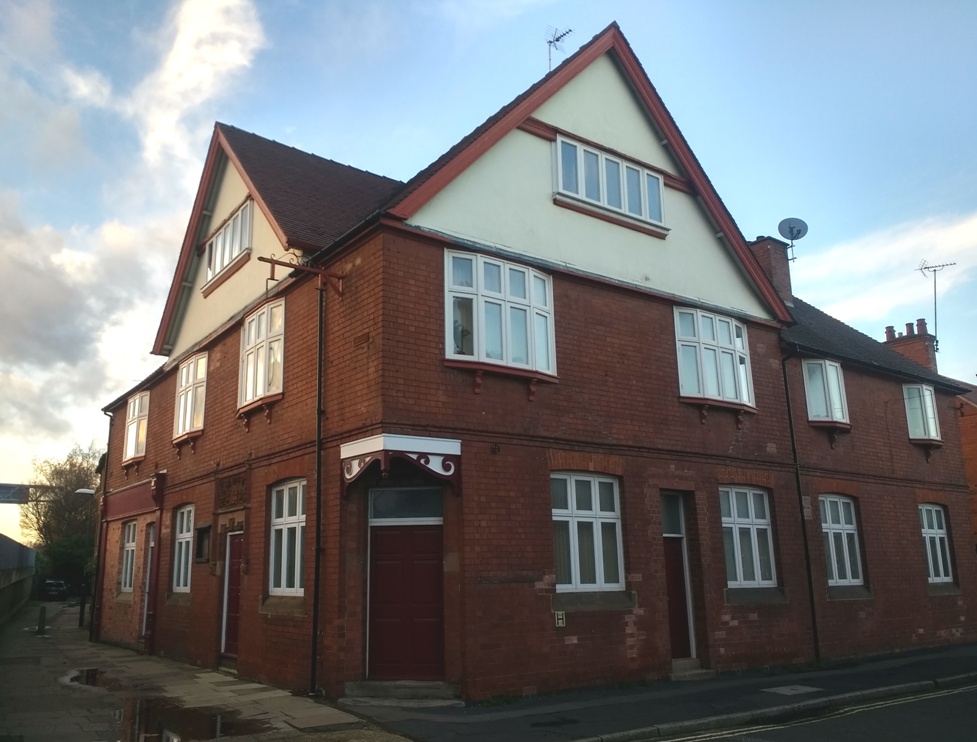
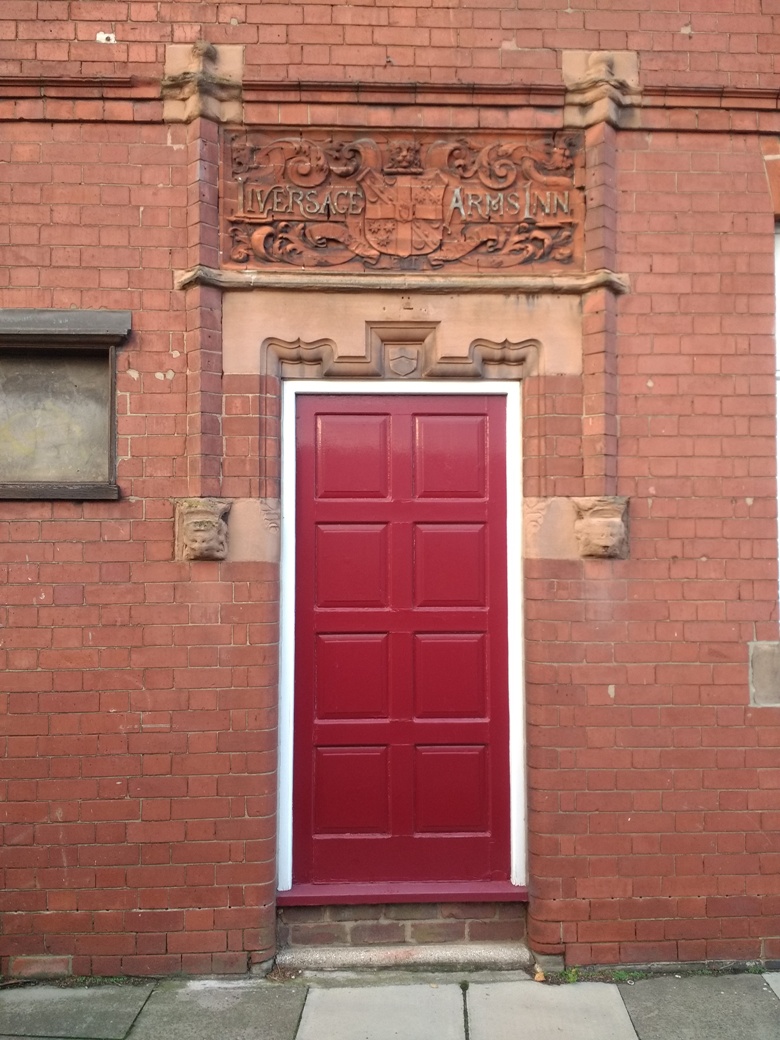
-
Masons Arms, Edward Street, Derby.
Pub situated on the corner of Edward Street and Arthur Street.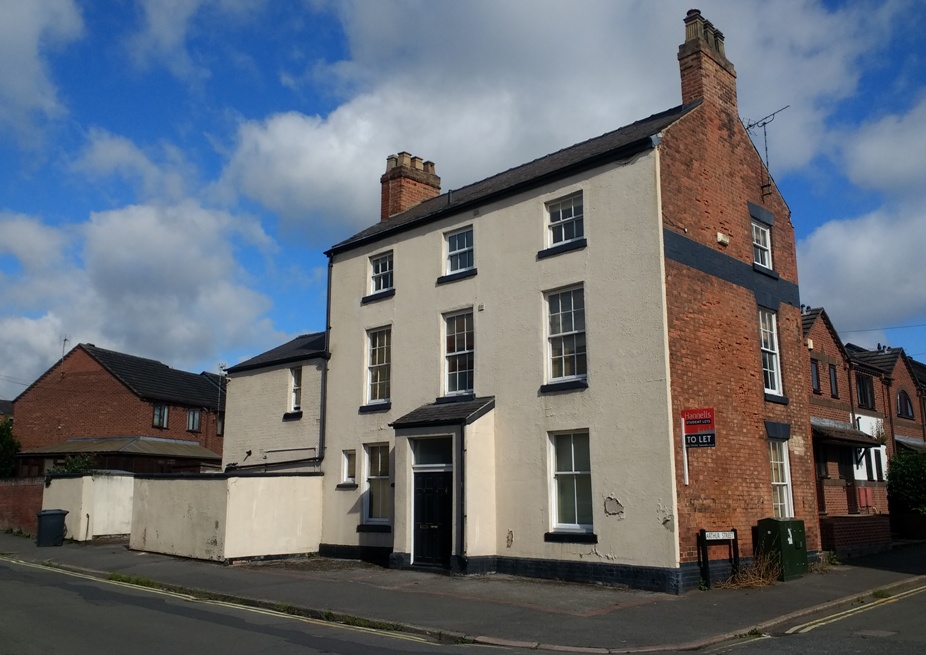
-
Portland Hotel, London Road, Derby.
Large corner pub and former hotel standing on the junction of London Road, Dickinson Street and Deadmans Lane. Currently being converted into flats.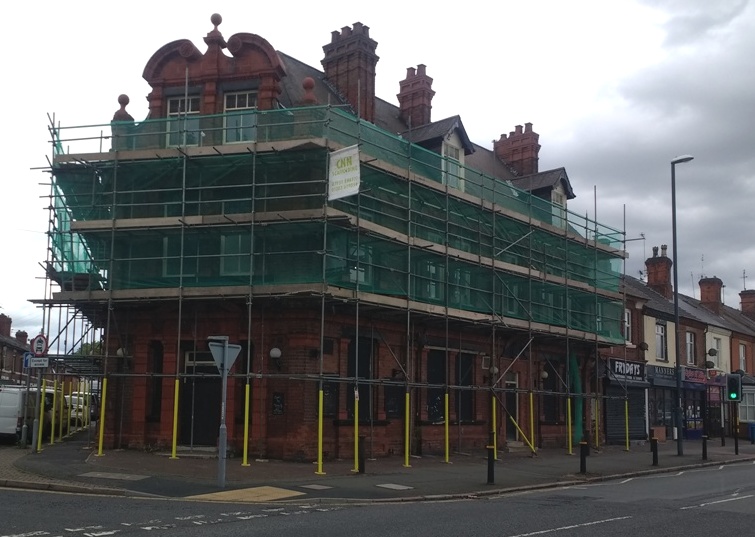
-
Rowditch, 246 Uttoxeter New Road, Derby.
Standing on the junction of Uttoxeter New Road and Uttoxeter Old Road, the pub remained largely unaltered up to its closure in August 2020. Steve and Jan Birkin were the last landlords.
Ref: WhatPub
Ref: Derby Telegraph -
Swan & Salmon, 140 Ashbourne Road, Derby.
Corner of Ashbourne Road and Chandos Pole Street. Now a general store.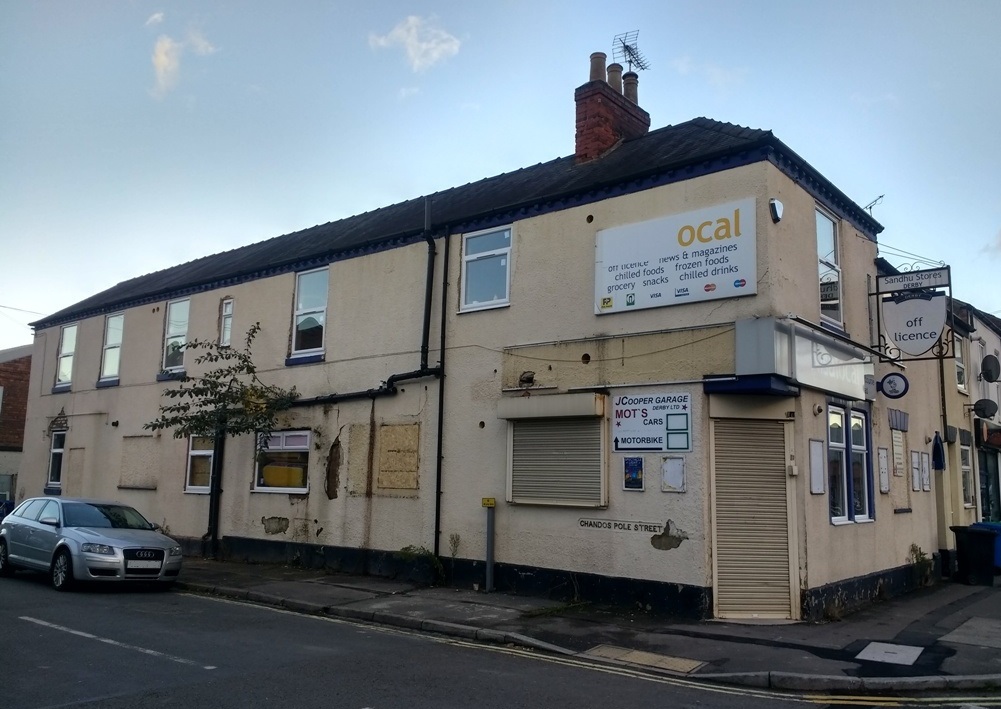
-
Waterside / Bridge Inn, Mansfield Road, Derby.
Multi-level pub on the corner of St Marys Bridge and Mansfield Road. Has stood boarded up since around 2019.
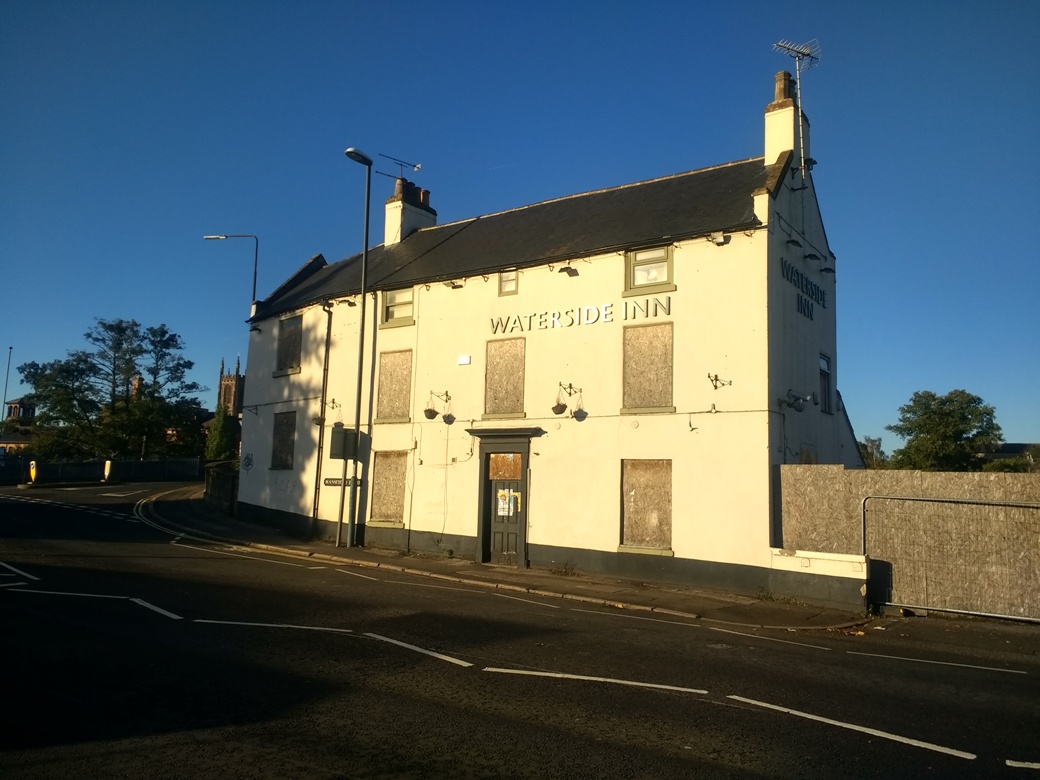
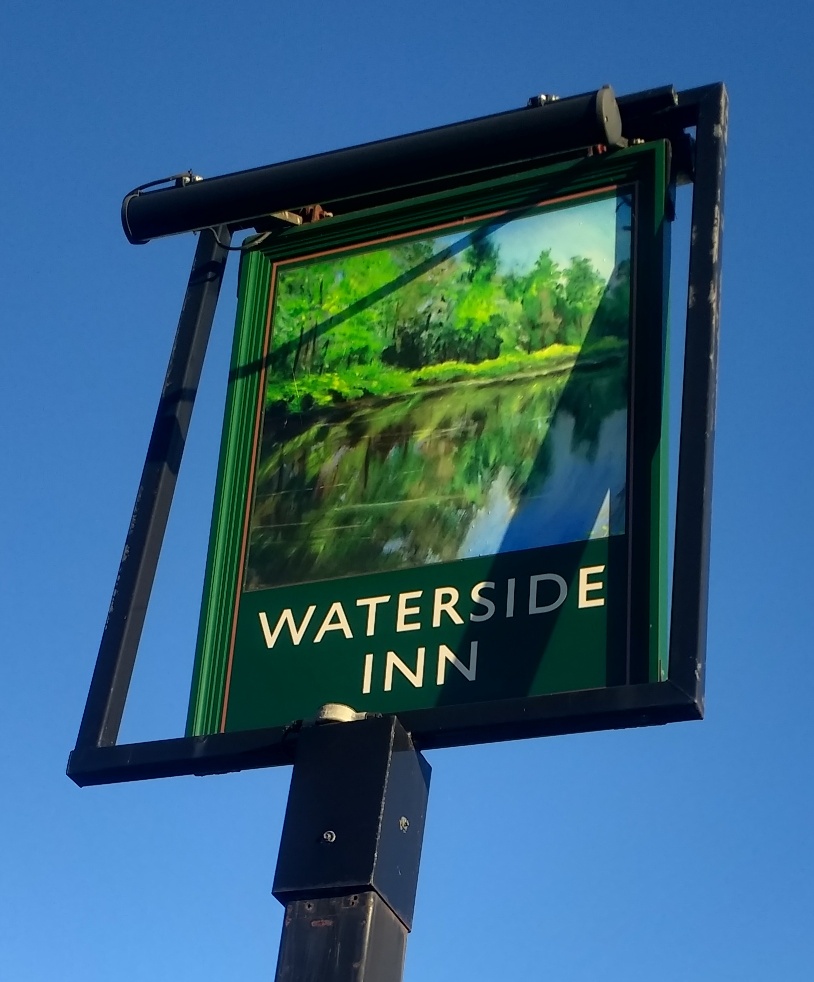
-
Wilmot, 45 Normanton Road, Derby.
Corner pub at the top end of Normanton Road opposite the labour exchange building. Now converted to flats but retains the original frontage.
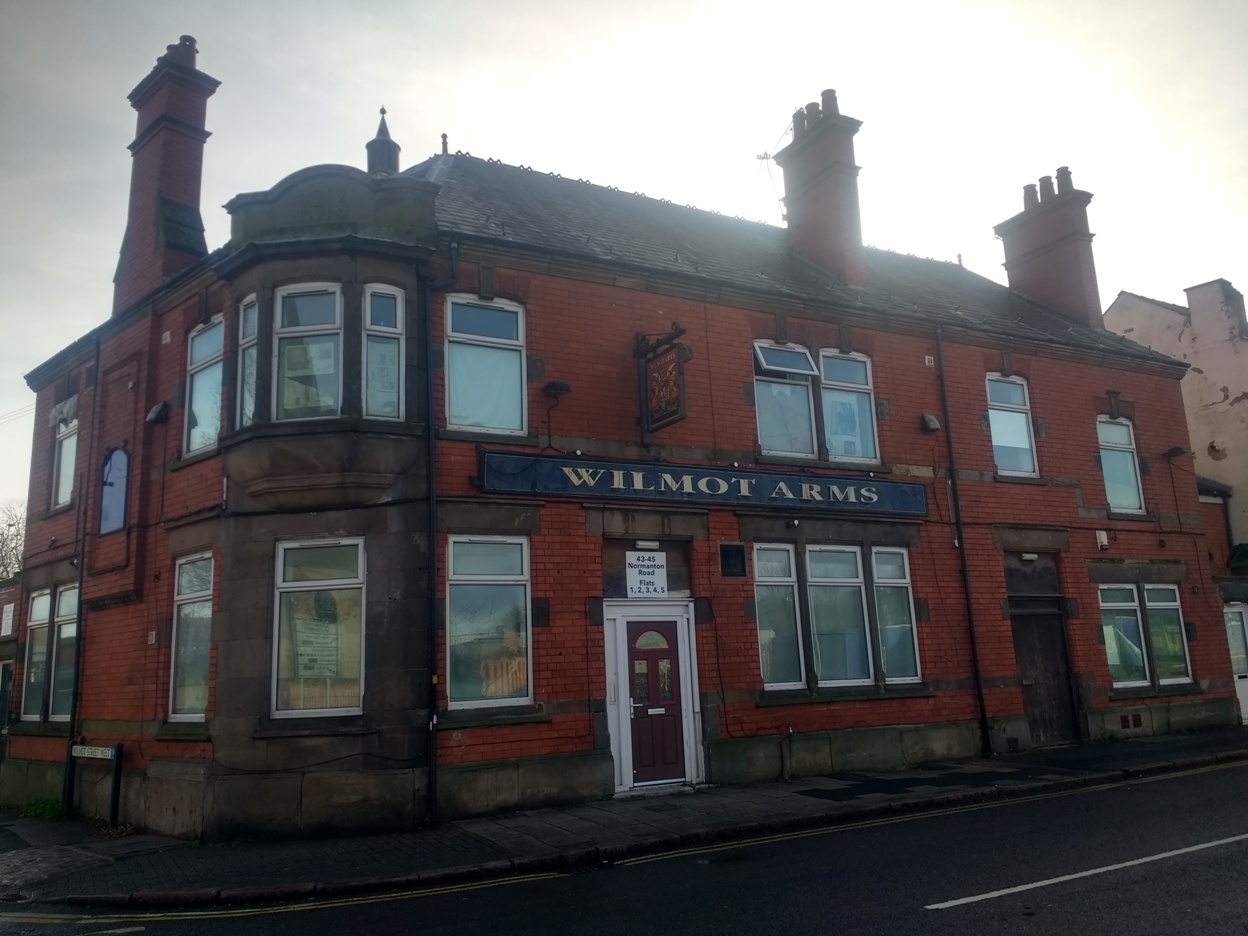
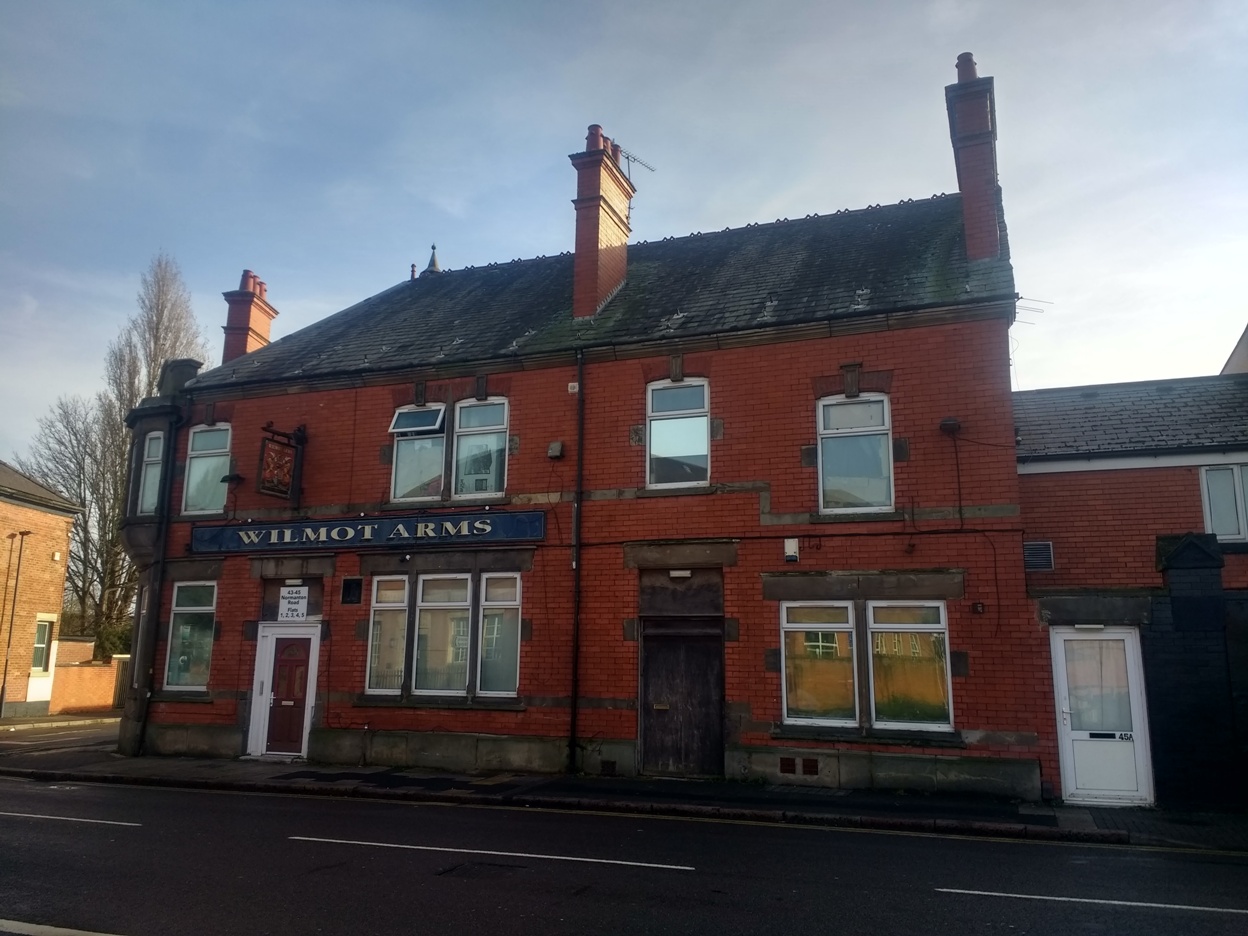
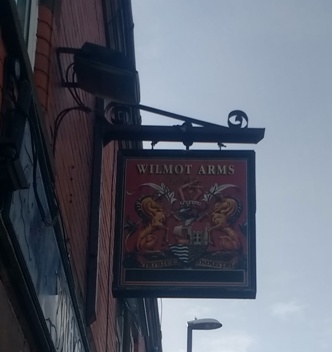
-
York Tavern, 23 York Street, Derby.
Appoximately half-way along York Street. Now a group of flats. The building is still named the York Tavern.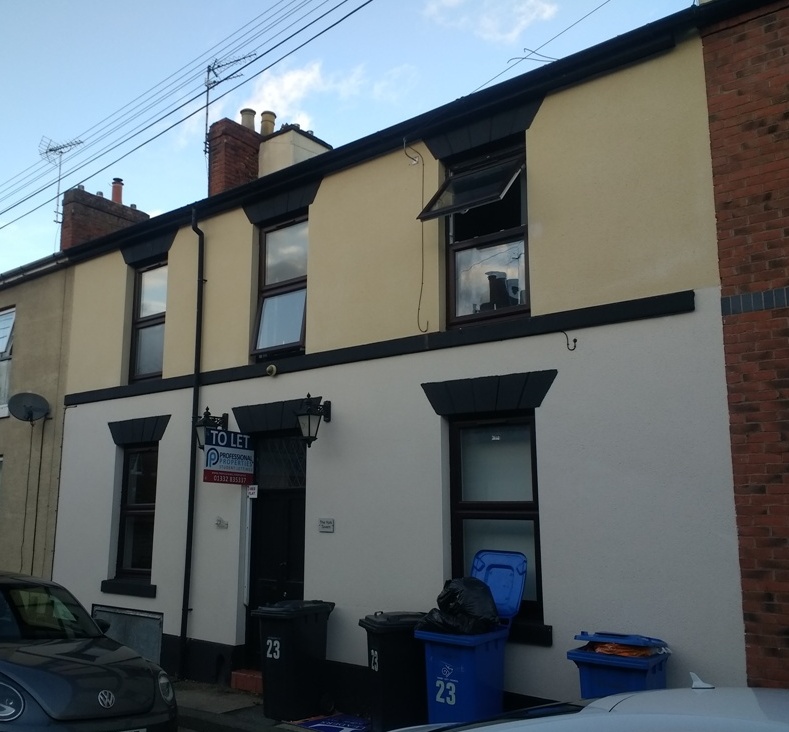
Alvaston
-
Roundhouse, 1196 London Road, Alvaston, Derby.
Large building standing on the juntion of Brighton Road and London Road. Formally called the Alvaston Hotel. The shape of the building resembles a railway roundhouse. Now in use as flats.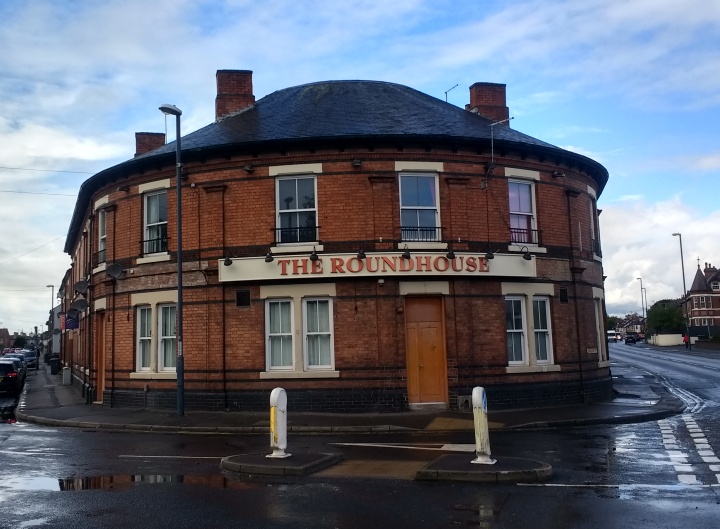
-
Harrington Arms, 1240 London Road, Alvaston, Derby.
White building set back from London Road now a shop. Still has the post for the pub sign in front of the building.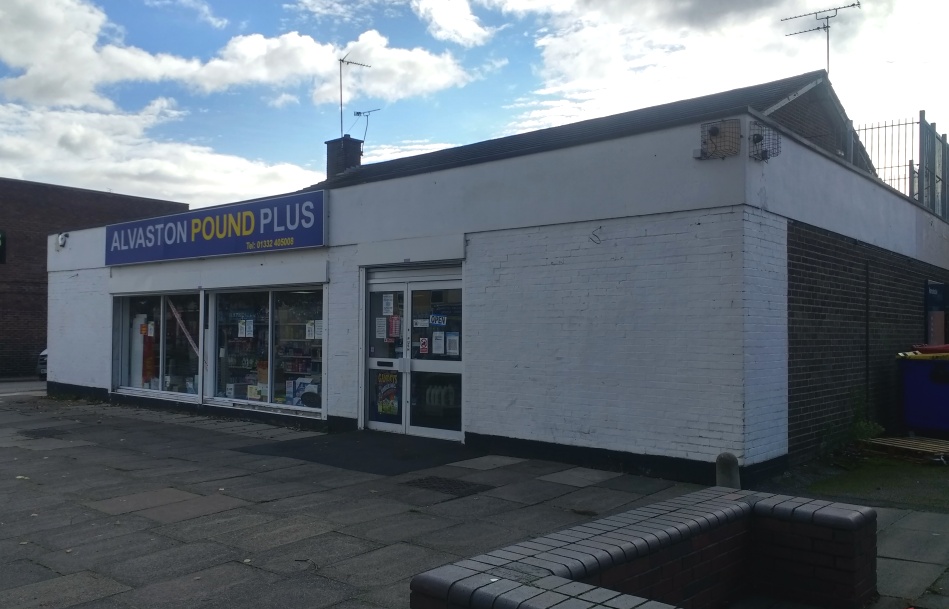
Chaddesden
-
Blue Boy, Wiltshire Road, Chaddesden.
Very large pub built in the Arto-Deco style and one of three such pubs built by the Offilers Brewery.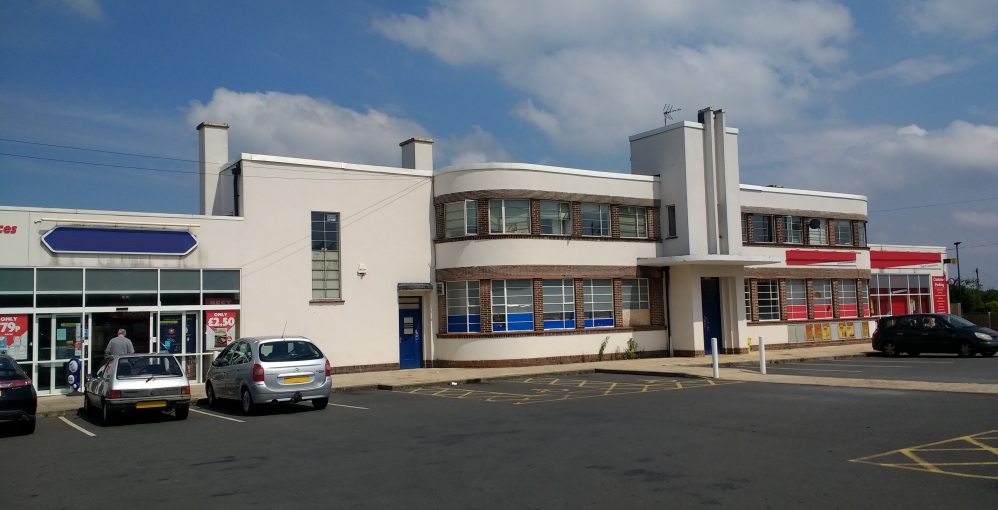
-
Kingfisher, Lexington Road, Chaddesden.
Modern building now a Co-Op general store.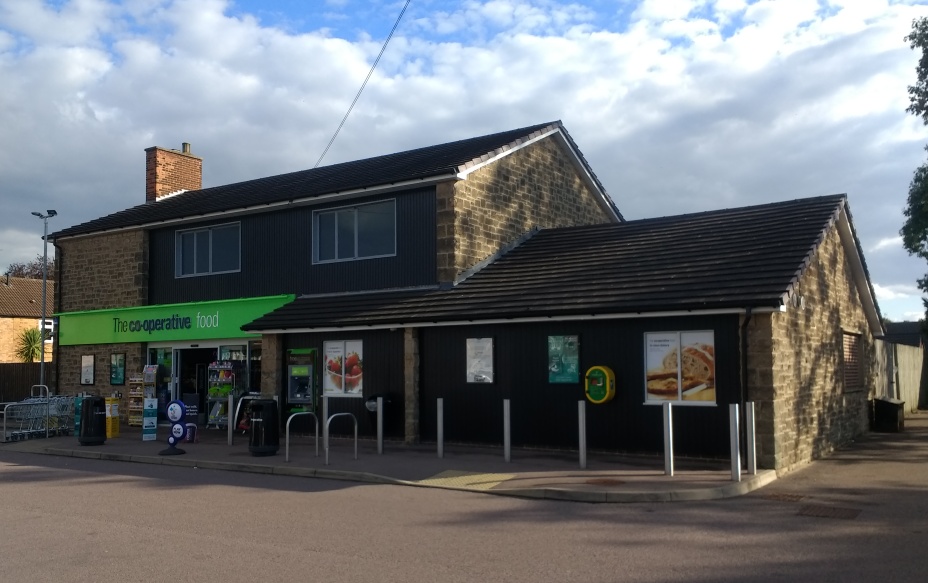
-
Spinning Wheel, Wood Road, Chaddesden.
Small building set back from the road and now a general store.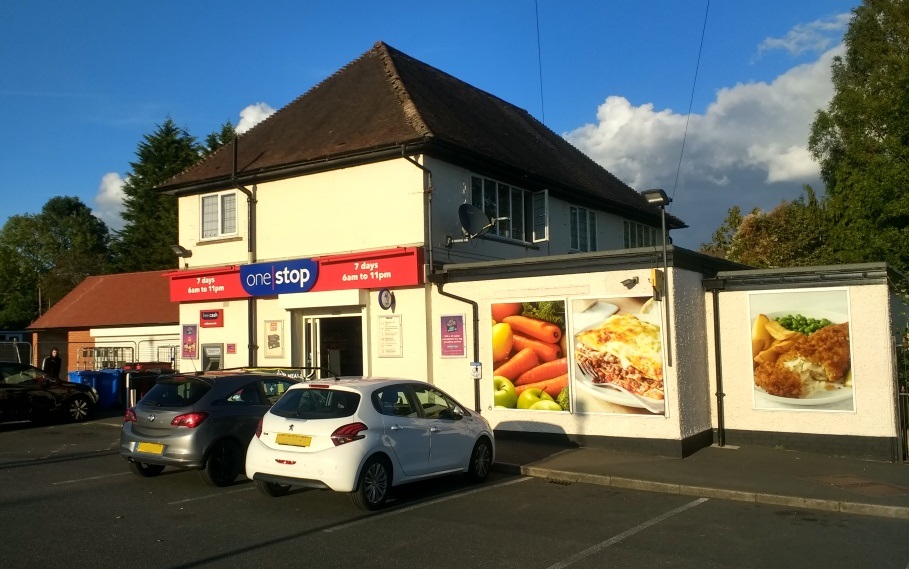
Chellaston
-
Red Lion, Derby Road, Chellaston.
A medium sized pub set back slightly from the road. Rebuilt from the ground up around 1963. Now a superstore.
Markeaton
-
Derbyshire Yeoman, Kingsway, Markeaton, Derby.
Large former hotel overlooking Markeaton roundabout and now a fast food burger restaurant.
Cavendish, Normanton, Sinfin and Sunny Hill
-
Blue Pool, Stenson Road, Sunny Hill, DE23 1HG.
One of the three "Blue" pubs built by Offilers Brewery in the Art-Deco style. Now a mini-supermarket.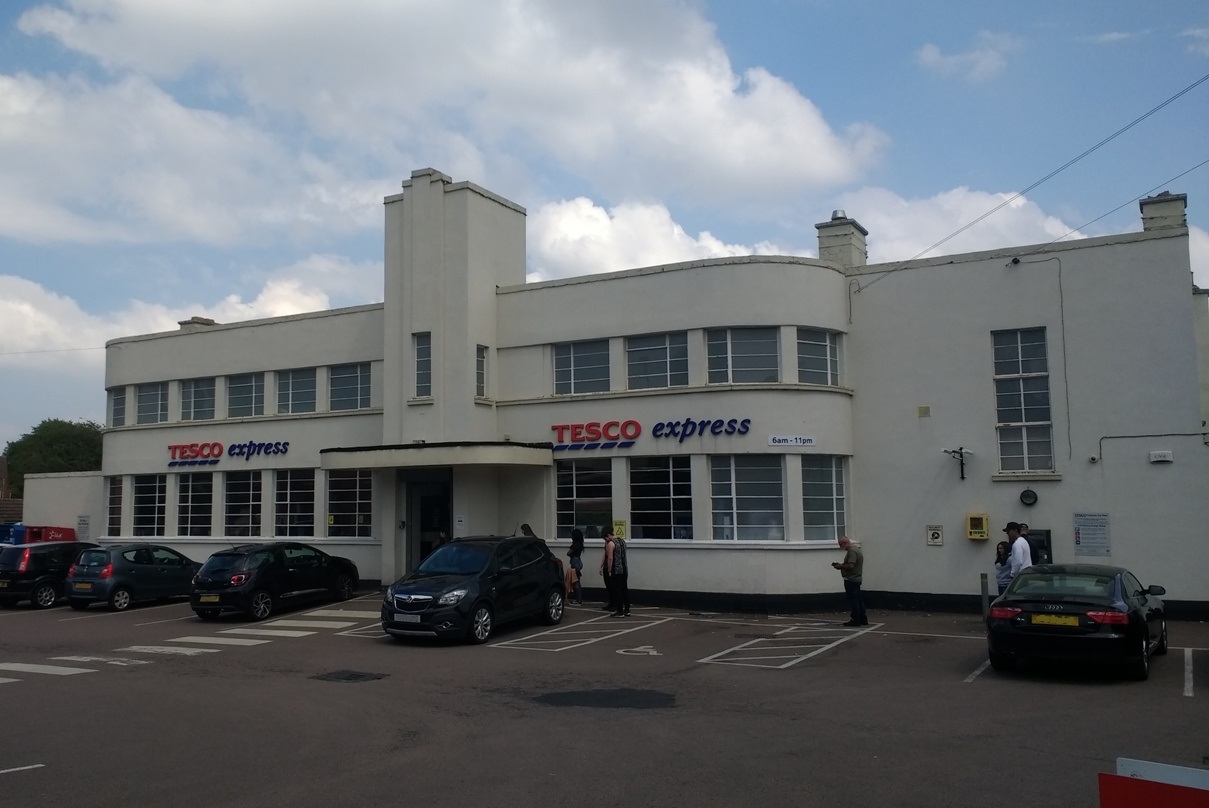
-
Cavendish Hotel, 129 Porter Street, Normanton.
Situated on the corner of Walbrook Road and Upperdale Road. Once owned by Offilers the pub but closed around 2007. The pub signs are still mounted between the stories of the building. The entrance on Walbrook Road retains the bub name and street enterance lamp.
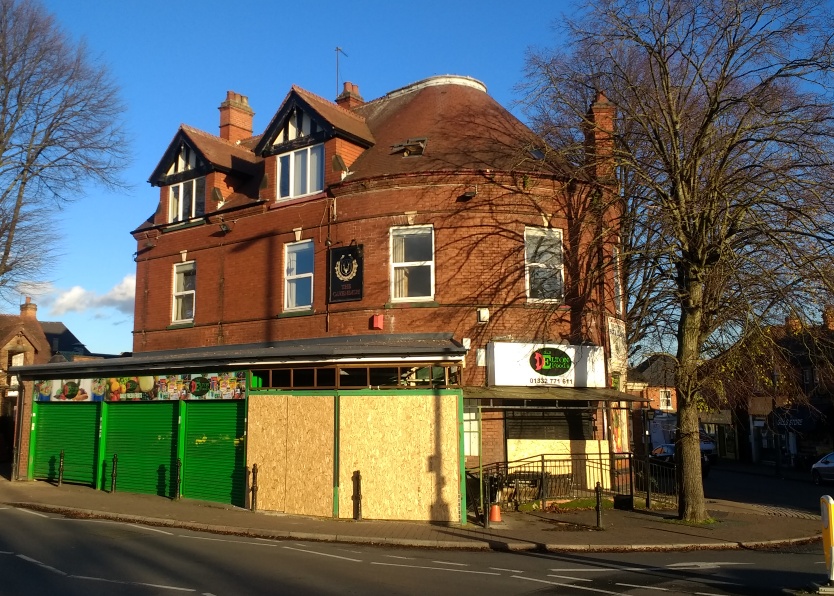
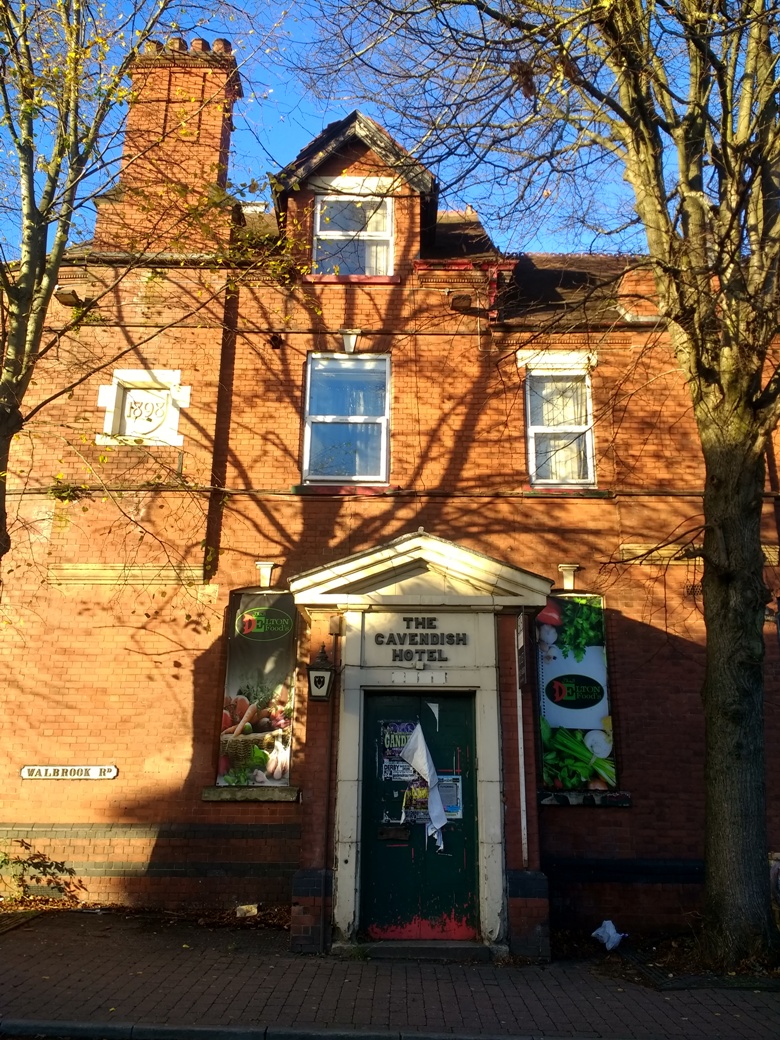
Ref: WhatPub. -
Grange, 69 Malcolm Street, Normanton.
Corner of Malcolm Street and Douglas Street. Until recently [mid-2020] the building still has the old pub sign hanging outside. The remains of a painted Inde Coope sign could still be made out on the Douglas Street side wall but painted over in 2021.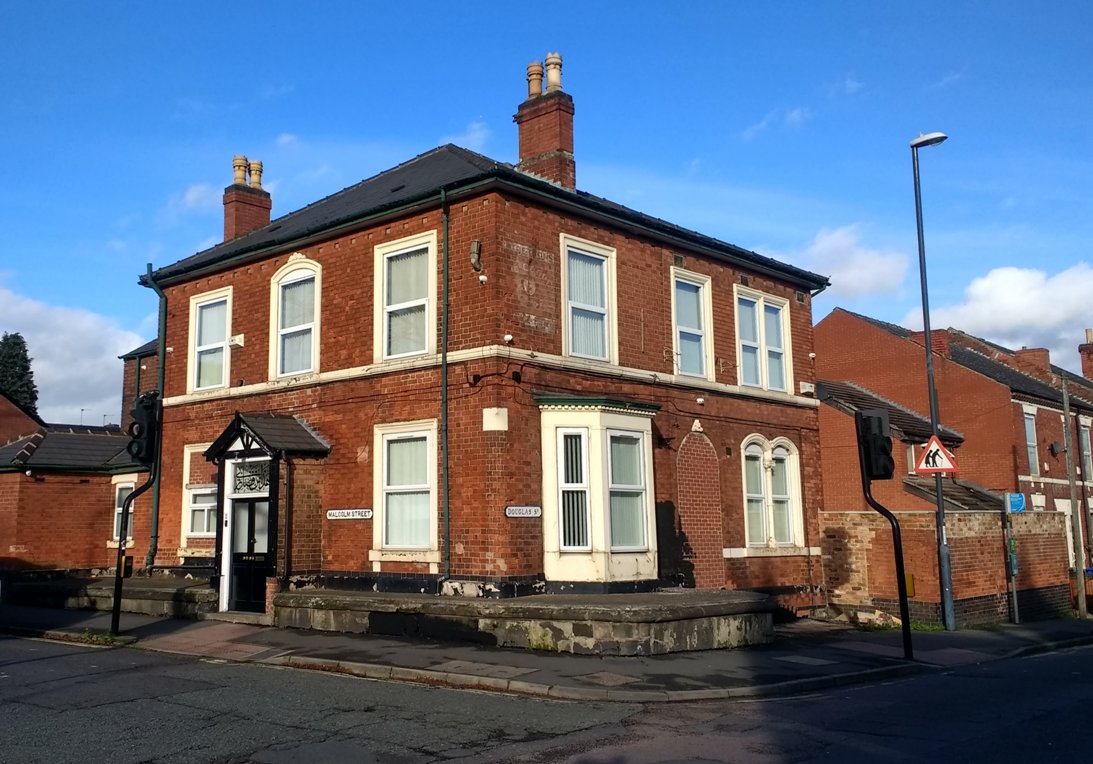
-
Greyhound Hotel, 202 Village Street, Sunny Hill, DE23 8DE.
A large building on the corner of Village Street and Derby Lane, which is set back from the road. Now the Derby Jamia Mosque. The main entrance on the corner has been concreted over but retails the ornate plinth, which is repeated at the side entrance.



Ref: WhatPub
Ref: PubsGalore. -
Mafeking Hotel, 129 Porter Street, Normanton.
Corner of Porter Street and Belvoir Street. Now residential.
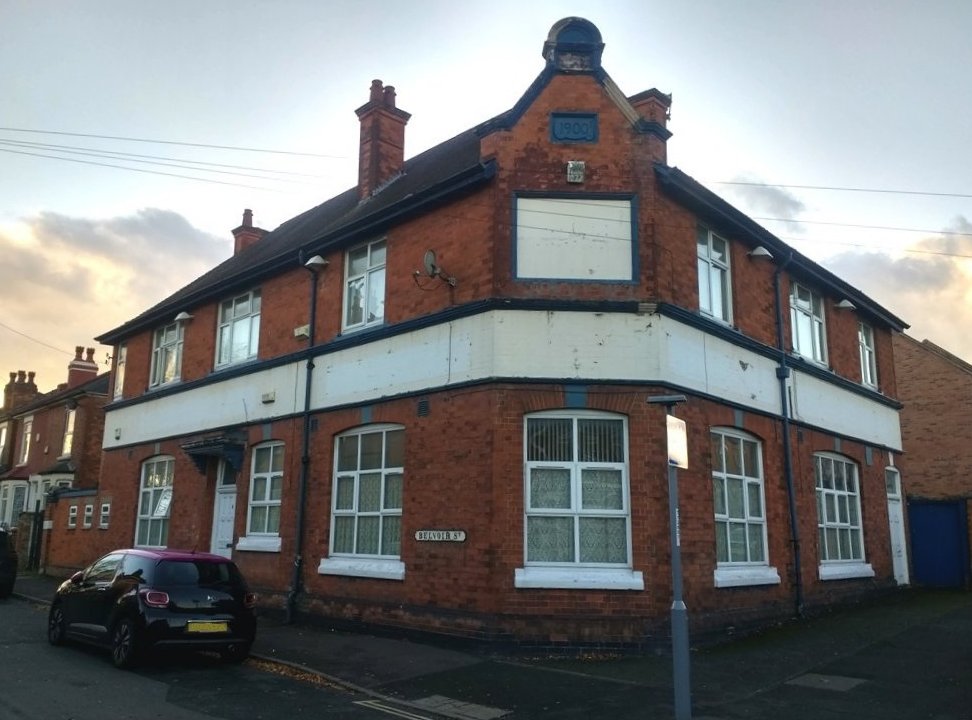 Ref: WhatPub.
Ref: WhatPub.
-
Normanton Hotel, Lower Dale Road, Normanton.
A large building over-looking the roundabout at the bottom of Normanton High street on the junction of Dale Road and Pear Tree Road. Now Normanton Pharmacy
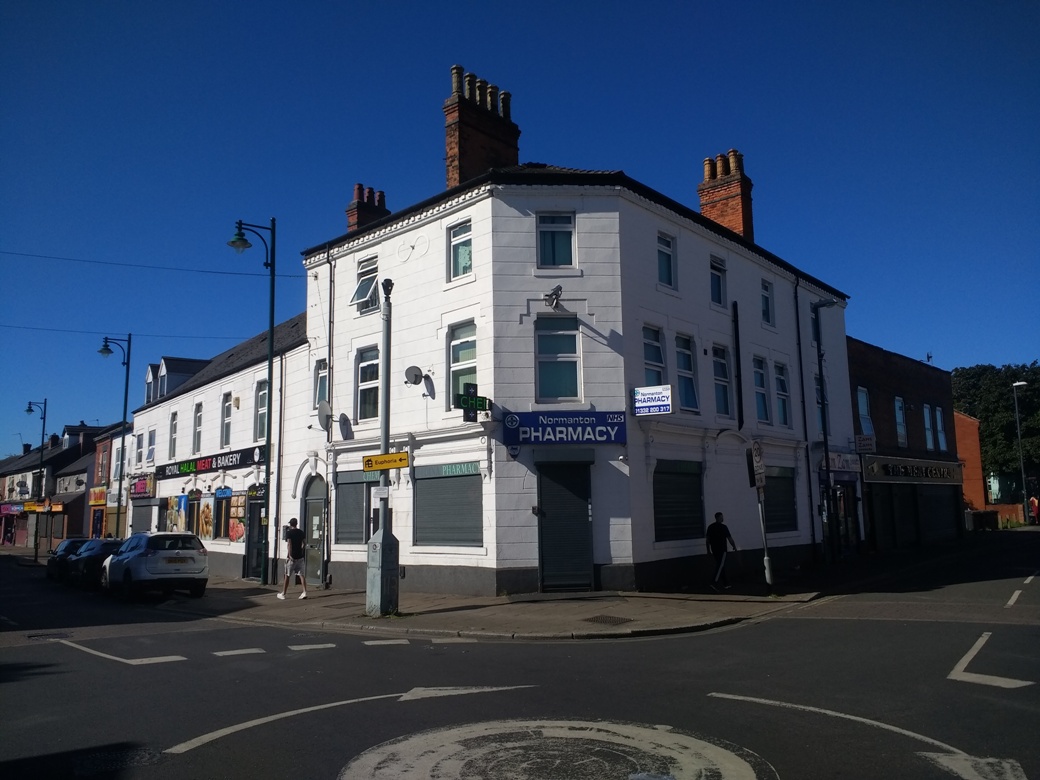 Ref: WhatPub
Ref: WhatPub
Ref: ClosedPubs.co.uk
Ref: Derby Telegraph -
Osmaston Park, Osmaston Park Road, Sinfin.
Large pub on the corner of Osmaston Park Road and Elton Road. Now a carpet shop, which continues to use the old pub sign post.
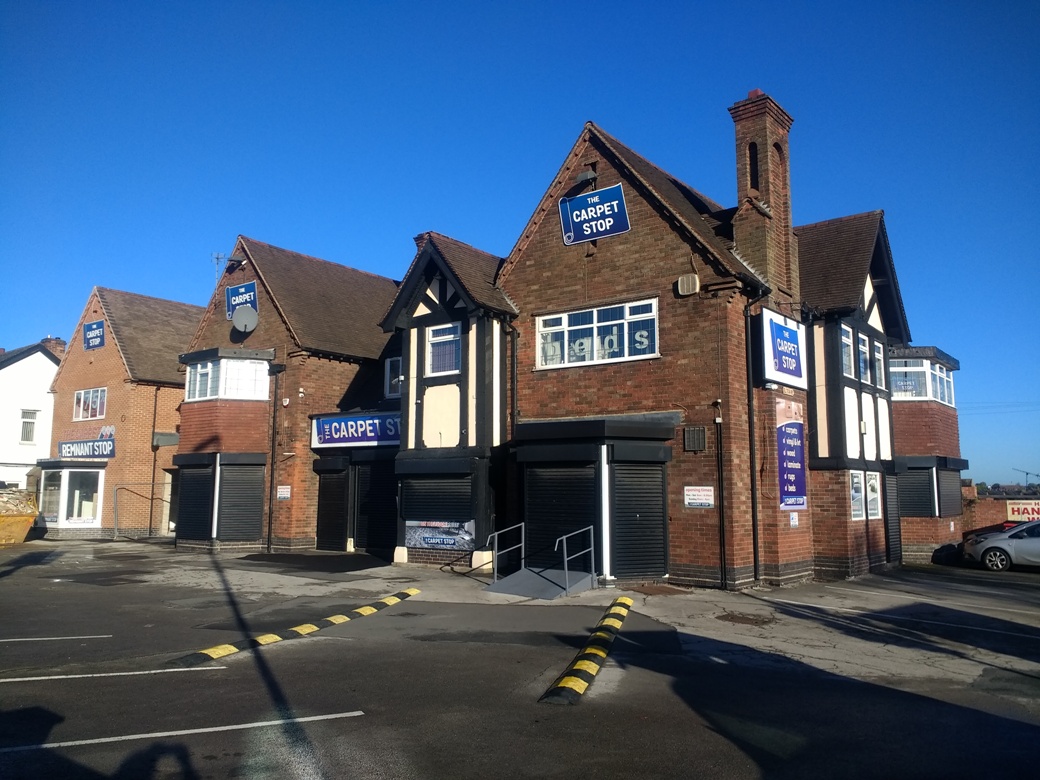

Ref: WhatPub -
Sherwood Forester, 85 St Thomas Road, Normanton.
A large building set back from the road on the corner of Village Street. Now the Ramgarhia Gurdwara. The already large building has been significantly extended. Note that the road-side sign still shows its brewery heritage.
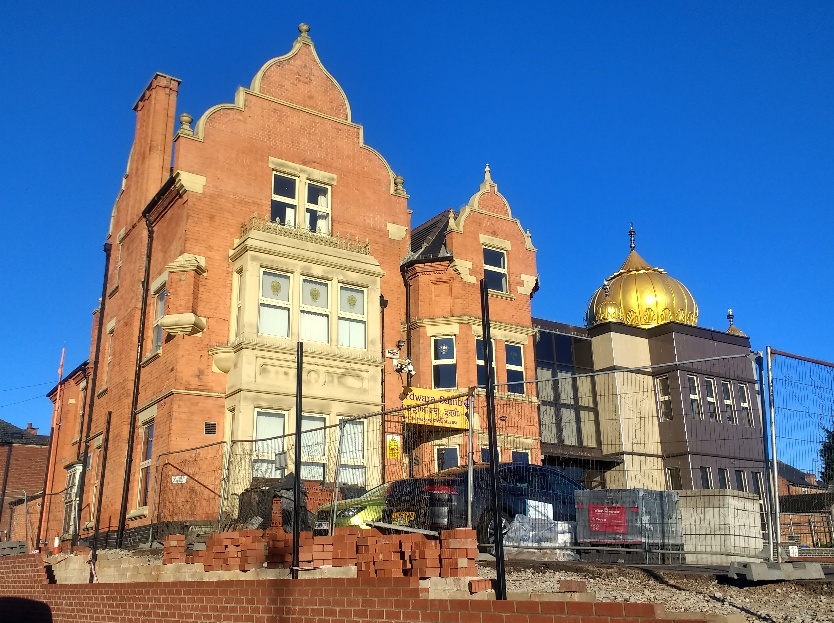
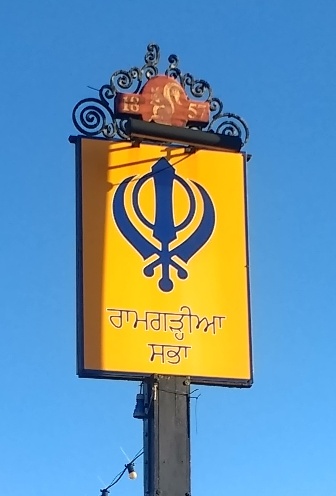
-
Windmill, 86 Dairy House Road.
Corner of Dairy House Road and Cambridge Street. Formally known as the Cambridge Hotel and renamed to the Windmill in 1987. The pub losed around 2000.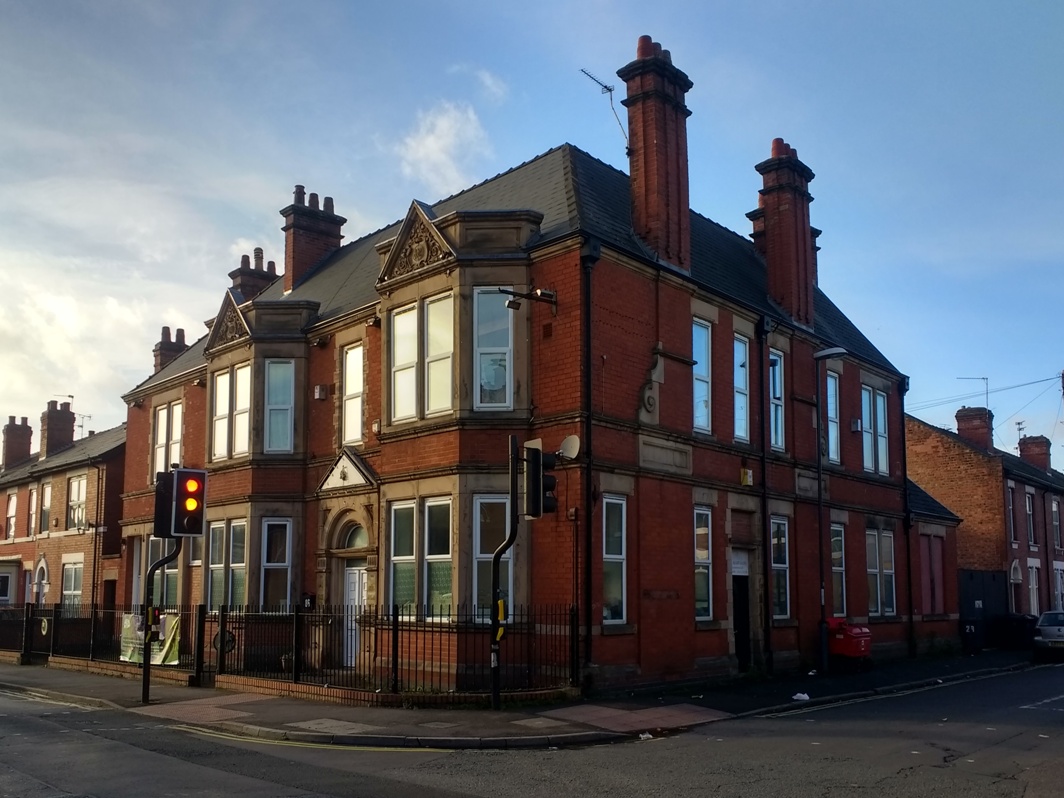 Ref: Derby Telegraph
Ref: Derby Telegraph
Borrowash
-
Noahs Ark, Derby Road.
Medium sized pub on the corner of Derby Road and Station Road in the centre of Borrowash. Now an e-cigarette shop.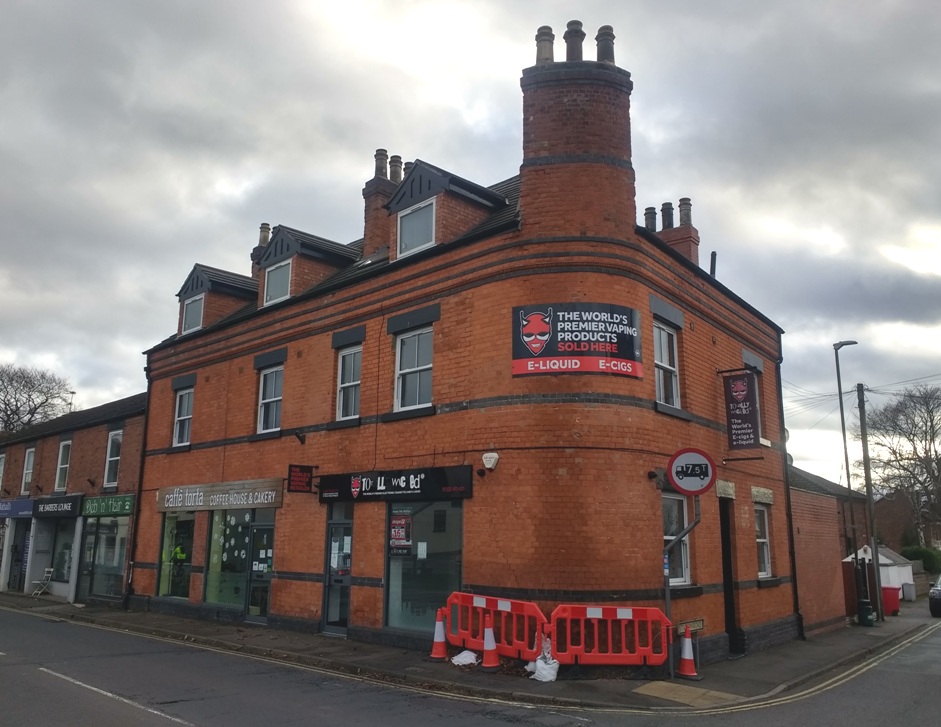
-
Wilmot Arms, Derby Road.
The pub lies set-back from the Derby road on the entrance to Borrowash from Derby.
Ref: Derby Telegraph - Well-known village pub to close next month.
Ref: Derby Telegraph - Derbyshire pub with poor reputation to be partly demolished for houses.
Findern
-
Wheel Inn, 25 Main Street. DE65 6AG.
Large building on the main High Street and the last pub in Findern.
Ref: WhatPub
Shardlow
-
Cavendish, London Road.
Stand alone building on the main road over the river bridge from the main part of Shardlow. Now a Chinese restaurant.
Books and Publications
Here are a list of books and publications which give information on the history of Derby pubs.
- The Illustrated History of Derby's Pubs by Maxwell Craven. Breedon Books ISBN 1859833306, printed 2003.
- Bygone Pubs of Derby and Derbyshire by Anton Rippon. North Bridge Publishing ISBN 9780992677978, printed 2014.
- Taverns in the Town Pubs of bygone Derby Breedon Books, ISBN 0907969003, printed 1982. A5 format, 32 pages many b/w photographs.
- Real Ale in and Around Derby 1976 Derby CAMRA, printed 1976. DL format, 30 pages. PDF copy.
- Real Ale in Derby 1981 Derby CAMRA, printed 1981. DL format, 56 pages. PDF copy.
- Real Ale in Derby 1989 Derby CAMRA, printed 1989. A5 format, 20 pages. PDF copy.
- The Malt Shovel, Spondon by David Hayes, published by Moorleys, ISBN 978-0-9570676-1-5, printed 2011 and reprinted in 2016, A5 format, 21 pages.
- Spondon Pubs and Clubs by James Wilson, published by Moorleys, ISBN 978-0-9930949-4-1, printed 2021, A5 format, 40 pages.
Links to other historical information on Derby pubs.
- Clovelly Hotel, Keddleston Road. Derby Drinker 100
- Cheshire Cheese, St Peter's Street. Derby Drinker 081
- Corporation Hotel, Cattle Market. Derby Drinker 091
- Derwent Hotel, The Spot, London Road. Derby Drinker 089
- Globe, Sacheverell Street. Derby Drinker 086
- Leopard Inn, Grove Street. Derby Drinker 092
- Lifeboat Inn, Wilson Street. Derby Drinker 083
- Lord Belper, Abbey Street. Derby Drinker 194
- Nottingham Castle, St Michael's Lane. Derby Drinker 097
- Old Wine Vaults, Market Place. Derby Drinker 098
- Reindeer Inn, Eagle Street. Derby Drinker 087
- White Bear, Derwent Row. Derby Drinker 082
Related Links
Links to other websites containing information on the history of Derby and Derbyshire pubs.
- ClosedPubs/Derbyshire/Derby list of closed pubs in Derby, many with pictures.
- ClosedPubs/Derbyshire list of closed pubs in Derbyshire, many with pictures.
If you have any feedback please send this to us pubsofficer@derby.camra.org.uk
Last updated 12th April 2024
